Mexicana de Aviación
 |
||||
|
||||
| Founded | 1921 | |||
|---|---|---|---|---|
| Ceased operations | August 28, 2010 | |||
| Hubs | Cancún International Airport Guadalajara International Airport Mexico City International Airport |
|||
| Frequent-flyer program | Mexicana Go | |||
| Member lounge | Elite Lounge | |||
| Alliance | Oneworld | |||
| Fleet size | 68 | |||
| Destinations | 48 | |||
| Company slogan | Vuela en lo más alto Since 2004 With The Most Modern Fleet Of The World Until 2004 |
|||
| Parent company | Tenedora K | |||
| Headquarters | Mexicana de Aviación Tower Mexico City, Mexico |
|||
| Key people | New Directors (TBA) | |||
| Website | www.mexicana.com | |||
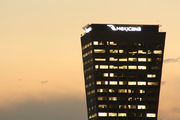
Compañía Mexicana de Aviación, S.A. de C.V., commonly known as Mexicana, was a Mexican airline, and was the first airline ever established in Mexico. The company ceased operations on August 28, 2010 as the new management has conceded the airline's financial troubles are too dire to continue operating. In addition to domestic services, it operated to various destinations in North America, Central America, the Caribbean, South America and Europe (until 8/31). Its primary hub was Mexico City's Benito Juarez International Airport, with hubs at Cancún International Airport, and Guadalajara's Don Miguel Hidalgo y Costilla International Airport.[1]
Mexicana's main competitors were Aeroméxico, although the two companies "code-share" on several routes, and Low Cost Carriers such as Volaris and Interjet. It was North America's oldest airline and the world's third oldest airline operating under the same name, after the Netherlands' KLM and Australia's Qantas. Avianca, which started operations as Scadta, is the second oldest airline of the world and the first of the Americas.
In 2009, the Mexicana group of airlines (including Mexicana Click and Mexicana Link) carried just over 11 million passengers (6.6 million on domestic routes and 4.5 million on international routes primarily to the US), using a fleet of some 110 aircraft.[2]
During the past three years the Mexicana group had managed to grow its share of what was a burgeoning domestic market, from around 22% at the beginning of 2007 to somewhere between 28% and 30% for most of the last 12 months. This had been achieved by the mainline Mexicana airline downsizing but ramping up activities at Mexicana Click (which was originally envisaged as a low-cost carrier), and Mexicana Link (its CRJ-operating subsidiary based at Guadalajara).[2]
Both Click and Link have closed their operations as well.
The airline joined Star Alliance in 2000, but left the alliance in 2004 and joined Oneworld on November 10, 2009.[3] Mexicana entered bankruptcy protection in August 2010, and attempted to restructure.[4] On August 27, 2010, Mexicana announced it would suspend operations indefinitely effective at noon August 28, 2010.[5]
Contents |
History
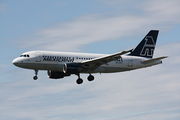
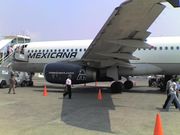
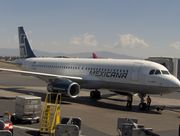
1920s
The "Mexicana" brand name was established on July 12, 1921, by American residents in Mexico L.A. Winship and Harry J. Lawson when the Compañía Mexicana de Transportación Aérea, S.A. (literally: "Mexican Company of Air Transport"), (CMTA) was awarded the Mexico City to Tampico route by the Mexican government. The purpose was to transport wages to the oil fields near Tampico, on the Gulf of Mexico. Mexicana's first aircraft type was the Lincoln Standard, a two-seat biplane, starting operations with two airplanes of the type. The 1920s were groundbreaking times for the airline, with air mail service being established and other services like aerial photography being undertaken.
William Mallory and George Rihl headed Compañía Mexicana de Aviación ("Mexican Aviation Company" or "Mexican Airline Company"), a competitor to CMTA; they acquired the latter's assets in 1924[6] and the company that emerged is the one that exists to this day. In 1925 Sherman Fairchild purchased a 20% stake in the Mexican airline introducing Fairchild FC2 airplanes in 1928. In February 1929, Juan Trippe of Pan Am took over the majority of the airline's stock, and the company opened its first international route, with service to the United States. Mexicana used the Ford Trimotor plane to operate the Mexico City-Tuxpan-Tampico-Brownsville, Texas, USA, route. Charles Lindbergh piloted the first flight on this route.
1930s
The 1930s saw route expansion and service improvement. Mexicana opened a route from Brownsville to Guatemala City, stopping over at Veracruz, Minatitlán, Ixtepec and Tapachula. In addition, flights were started to El Salvador, Costa Rica and Cuba, and the association with Pan Am gave them access to Nicaragua and Panama too, through Pan Am's Miami base. (Pan Am had undertaken flights from Mexico City to Miami.) Mexicana also became then the first foreign airline ever to fly to Los Angeles when it began flights on January 3, 1936.[6] The fleet expanded during that decade, as eight Fairchild FC2s and three Fokker F.10s were incorporated.
1940s
The 1940s were primarily a period of domestic growth, although service was established from Mexico City to Havana. Routes were opened to Monterrey, Nuevo Laredo, and Mérida. Additionally, a night flight to Los Angeles was established. The Mérida flights also operated at night. Mexicana initially used Douglas DC-2s for these flights but, as time went on, larger aircraft, such as the Douglas DC-3s, were acquired and, later, Douglas DC-4s. The DC-3s were known as El Palacio Aéreo (The Air Palace) for their luxury and comfort. The DC-4 allowed Mexicana to offer non-stop service on the Mexico City to Los Angeles route. By this decade, Mexicana was able to create a certified pilots' school in Mexico City.
1950s
The 1950s saw the airline's growth slow, but Douglas DC-6s were welcomed to the fleet, and a flight attendant school was opened. The DC-6s were put to work on the Mexico City to Puerto Vallarta and Mexico City to Oaxaca routes. Service to San Antonio, Texas was initiated later in the decade.
1960s
In the 1960s, four De Havilland Comets were bought and Mexicana entered the jet age on July 4, 1960 with the first jet service between Mexico City and Los Angeles (One of which is being restored by Seattle's Museum of Flight.) At this point, Mexicana was still a Pan American Airways subsidiary and these Comets were intended to replace Pan American's Boeing 707s should this type not fulfill the expectations of Pan American's owner, Juan Trippe. Despite its use of technologically advanced aircraft types, competition was stiff. By the late 1960s, the company faced bankruptcy. Amidst the difficulties, the airline received its first Boeing 727.
The difficult times brought about a change in the airline's administration and on January 15, 1968, Mexican Crescencio Ballesteros, took over as chairman.[6] Manuel Sosa de la Vega was appointed as President and CEO. The new administration implemented strategic plans and the airline was able to recover from its economic problems soon after.
Despite its economic revival, 1969 was a difficult year for the airline as it lost two Boeing 727 jets. The first occurred in bad weather on a flight from Mexico City to Monterrey. The second occurred on an international flight between Chicago and Mexico City.
1970s
In 1971, Mexicana started flights to Luis Muñoz Marín International Airport in San Juan, Puerto Rico, a route it would maintain for more than 25 years without interruption, and to Denver, Colorado. The jet fleet kept expanding and eventually consisted of 19 jets, the largest jet fleet in Latin America at the time. They also started a flight simulator service with a 727 simulator at their hub in Mexico City International Airport. By this time Mexicana had the largest fleet of 727s outside the USA.
1980s
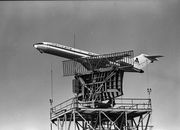
During the 1980s, Mexicana's growth was static. However, a few events touched the company. In 1981, three DC-10-15s were received and began making their way through the airline's Caribbean routes. This was the first "wide-body" aircraft type Mexicana ever operated and was intended for use on high-density routes. In 1982, the Mexican government acquired 58% of the airline and re-privatized it in August 1989.[6][7] In 1984, construction was completed on the company's new corporate headquarters, a building 30 stories tall meant to resemble an air traffic control tower, on Xola Avenue in Mexico City. In March 1986, a Boeing 727, Mexicana Flight 940, en route to Puerto Vallarta suddenly caught fire and crashed in the mountains of western Mexico, killing everyone on board. This is the most recent fatal accident involving a Mexicana aircraft. In 1988, Aeronaves de Mexico (AeroMexico), Mexicana's closest rival, declared bankruptcy. Consequently, Mexicana took over some of AeroMexico's longer flights during the 1990s, including flights to Canada and South America.
1990s
For Mexicana, the 1990s kept bringing changes. The Mexican airline industry was deregulated, which allowed new competitors to form. Seeking to remain competitive and modern, the airline incorporated European-built Airbus A320s in 1991 and Dutch Fokker F100s in 1992. In 1993, a reorganized AeroMéxico took over as the company struggled financially. During the mid-1990s, the Mexican economy was hard-hit by the devaluation of the Mexican peso and Mexicana, AeroMéxico, and their regional affiliates were nationalized when their parent company, CINTRA (Corporación Internacional de Transporte Aereo), was taken over by the government. The airlines remained in their merged state until 2005. As happened in 1967, a new management team was hired, this time headed by President and CEO, Fernando Flores. The company was reorganized and rationalized, with a new emphasis placed on international service. Unprofitable routes were cut and the DC-10s were retired. The airline ventured deep into South America by adding flights to Lima, Peru, Santiago de Chile, and Buenos Aires, Argentina and further into North America, adding flights to Montreal, Canada. To operate these new and longer routes, the airline leased Boeing 757s, a medium-sized jet that is more modern and smaller than the DC-10 and better suited to the airline's needs at the time. Another aspect of this re-organization involved the creation of alliances. It was part of the regional alliances, LatinPass and Alas de America, and later formed an alliance with United Airlines. This latter alliance brought Mexicana into the network of global alliances, as it eventually led the airline into the Star Alliance. Recognizing the usefulness and importance of the Internet, the airline launched a website meant to promote its service and eventually included a reservation center, allowing potential passengers another option for purchasing tickets. Also around this time, Mexicana adopted a new color scheme, with assorted colors on each tail of the planes.
1995-2005
In 1995, Mexicana was merged with AeroMéxico as a part of CINTRA. In 1996, the old assorted color scheme was dropped in favor of just the green tail with white on the majority of the plane and the word "Mexicana" in black letters. In the 2000s, Mexicana had continued to grow. It celebrated its 80th anniversary in July 2001, just before the terrorist attacks of September 11 sent worldwide aviation into a tailspin. Nevertheless, the airline continues to evolve. It officially joined the Star Alliance in 2000 amid much fanfare, only to exit in March 2004 in response to rapidly changing market conditions related to United Airlines bankruptcy, and the aftershocks of sept-11, 2001 terrorist attacks. The current CEO, Emilio Romano, has stated in the airline's in-flight magazine, VUELO, that the airline left the alliance to pursue more effective code-sharing relationships with other airlines. Simultaneously, the airline created an alliance with American Airlines and several oneworld Alliance partner leading some to speculate whether the airline will join that alliance. Nevertheless, it has maintained ties to some of its former Star Alliance partners, such as Lufthansa. In 2003, the airline retired the remaining Boeing 727 after operating the type for almost 40 years. These aircraft were replaced with newer A320, A319, and A318 types. Thus, the airline, once an important Boeing Company operator, is now an important Airbus Industry airline, although it still operates one Boeing aircraft. Notably, the airline's long haul operations are conducted by Boeing 767s, the latter type introduced in December 2003, although fleet renewal plans may see long haul operations taken over by Airbus types and the Boeing 757s were phased out of the fleet.
2005
2005 was an important year for Mexicana as the airline was sold and several low cost carriers were established in Mexico to compete with AeroMéxico and Mexicana. For its part, Mexicana rebranded its regional subsidiary, AeroCaribe, as "Click Mexicana" and promotes it as a low cost carrier. This is part of the company's plan to remain competitive as the aviation industry changes and competition intensifies. Another component of this plan includes increasing its international presence. Also, the color scheme was changed again to a dark blue tail and blue lettering on a white background.
Sale
Despite government announcements indicating that the airlines were going to be privatized, that move did not occur until November 29, 2005, when CINTRA sold Mexicana and its subsidiary, Click Mexicana, to the Mexican hotel chain Grupo Posadas for US$165.5 million. The road to privatization was long and winding. The government reversed its course on several occasions. At times, it proposed to sell Mexicana and AeroMéxico separately; other times, it proposed to sell them together to increase the bid price. It also proposed to sell the companies merged, but separate from their regional affiliates to increase competition. Several companies expressed interest in purchasing one or both of the airlines. For example, Iberia Airlines of Spain announced it had plans to buy part of both Mexicana and Aeroméxico. However Mexicana's owners rejected the offer possibly because another Iberia-owned Latin-American airline, Viasa of Venezuela, had gone bankrupt under Iberia's ownership. Further, Aerolíneas Argentinas had previously rejected a similar offer by Iberia.
2006-2007
On July 12, 2006 Mexicana announced that it intends to begin service to several new destinations in the United States: Seattle, Detroit, Charlotte. It intended to return to Puerto Rico, but the service came back only as a charter operation. It is also negotiating with the state of Arkansas officials to begin service to Little Rock National Airport. Mexicana is named "Best Airline in Latin America" in 2006 and "Best business in Central and Latin America".
2008
On 9 April 2008, Oneworld invited Mexicana to join the alliance and the airline is expected to join the alliance on 11 November 2009, together with its two subsidiaries MexicanaClick and MexicanaLink, thus adding 26 destinations to the network.[8] Iberia was the sponsor of Mexicana's invitation into the Oneworld alliance. Mexicana was to compete with SkyTeam members Aeroméxico and Copa Airlines (who has since left SkyTeam) (possibly to be a Star Alliance member because of the Continental Airlines' move to that alliance) and Star Alliance potential member TACA and member TAM for US and Europe service to Latin America. Mexicana will start new international flights to the US, Europe and Brazil to better leverage its position.
In October 2008, Mexicana announced the introduction of three additional destinations, by serving London's secondary airport (Gatwick), São Paulo (Brazil) and Orlando (U.S.). Service commenced December 8 for São Paulo (GRU) and Orlando (MCO), followed by London (LGW) in January 9. With this service expansion, Mexicana becomes the second Mexican airline with service to Europe and Brazil (Aeromexico has long established service to Paris, Madrid, Rome and Barcelona in Europe, and São Paulo in Brazil), and first with service to the United Kingdom. Mexicana will compete on the basis of lower prices with British Airways, albeit BA's flight serves London's premier airport (Heathrow). Except for Orlando which will be operated with a medium range Airbus 320, London and São Paulo will be operated with 2 leased Boeing 767-200ER. In addition, Mexicana announced a Mexico City to Madrid route to compete with Aeromexico and compliment its partner's (Iberia) existing service. Mexicana has announced that it will begin service to Madrid beginning in Feb/09 through the acquisition of 2 Airbus A330-200 not taken by XL due to bankruptcy. These aircraft types are well suited for medium-density, long-range travel. The company also unveiled the new colorful livery on November 27, along with "Mexicana Click" brand new name for Click Mexicana.
2009
On 4 February 2009, Mexicana has won a concession to operate a new feeder airline that will complement the routes currently covered by Mexicana and Mexicana Click.[9] The new airline will be called MexicanaLink and will operate in lower density routes to feed mainline operations from Guadalajara's international airport. The airline will fly Boeing 717 aircraft.
Also in February 2009, Mexicana applied to the US Department of Transportation to initiate daily, non-stop service between Guadalajara, Jalisco and New York utilizing either an Airbus A319 or the larger Airbus A320.[10] On the 25 of February Mexicana joined the Airbus MRO network evaluating the Airbus A350 as it looks to further expand its new long-haul network.
Mexicana officially joined the Oneworld alliance on November 10, 2009. It is a former member of the Star Alliance, which it left in 2004.
2010
Mexicana planned to replace their 2 767-300ER's with Airbus A330-200's in order to keep commonality with the rest of their wide-bodied fleet.
Mexicana filed for bankruptcy on August 3, 2010 in both the U.S. and Mexico, following labor union disputes; a debt of US$125 million was reported.[11] Subsequently, the airline scaled back its operations, suspending ticket sales and announcing termination of selected routes.[12] In early August 2010, the airline offered pilots and flight attendants a stake in the business in exchange for new labor terms."[13] On August 24, a Mexican consortium called Tenedora K announced that it had bought 95% of Nuevo Grupo Aeronautico; pilots would hold the other 5%.[14]
After 89 years of service, Mexicana suspended all operations at noon CDT on August 28, 2010.[15] Aeroméxico offered discounted tickets to passengers stranded by Mexicana's suspension of operations.[16] American Airlines and American Eagle Airlines also offered assistance,[17] providing help to passengers between the 48 contiguous U.S. states and Mexico.[18]
Subsidiaries
- MexicanaClick
In 2005 Aerocaribe was renamed Click Mexicana and converted all of its fleet from the older generation DC-9s to Fokker 100 aircraft. Click is a wholly-owned subsdiary of Mexicana de Aviacion.
Click is Mexico's first low-cost airline. Mexicana employs Click mostly on domestic operations while Mexicana focused on international and longer domestic routes. Click flies primarily in the Yucatán Peninsula and northern Mexico and its sole international destination is Havana, Cuba. Mexicana is considering the possibility of expanding Click's fleet to incorporate A319 which could serve destinations in Central America and the Caribbean. Click currently has 22 F100 aircraft in an all economy-plus layout. The main cabin has a smart look with an all grey-leather seats with the Click logo in the headrest. The seat pitch is 35°. In 2008 Mexicana and Click were invited to the Oneworld alliance at the member and member affiliate level, respectively.
Mexicana rebranded Click Mexicana as MexicanaClick with the announcement of the new corporate livery late-November 2008. MexicanaClick highlights the Mexicana linkage.
Mexicana, Mexico’s largest airline, said it signed in March 2009 an agreement with Boeing to lease 25 airplanes for its low-cost subsidiary. The multi-year contract is part of Mexicana’s fleet renovation program, and the Boeing 717s will replace the Fokker F-100 aircraft that MexicanaClick currently operates. The subsidiary, MexicanaClick, is expected to begin receiving the planes this month from Boeing’s financing and leasing arm, the companies said in a press release. 16 of the planes were previously used by Midwest Airlines, which returned the aircraft to Boeing when the airline restructured last year. Terms of the lease weren’t disclosed.
- MexicanaLink
- Other
- MexicanaLoyalty
- MRO Services
Former subsidiaries
- Aerocaribe
- Aeromonterrey
- Mexicana Cargo
Destinations
Mexicana codeshares with the following airlines:[19]
|
Fleet
The Mexicana fleet consists of the following aircraft (as of July 2010)
| Type | Total | Orders | Passengers (Elite/Coach) |
Routes |
|---|---|---|---|---|
| Airbus A318-100 | 10 | 100 (12/88) | Short-Medium haul Central America, Mexico and the United States |
|
| Airbus A319-100 | 25 | 120 (12/108) | Medium haul Canada, Central America, Mexico, South America and the United States |
|
| Airbus A320-200 | 27 | 150 (12/138) | Medium haul Cuba, Mexico, South America and the United States |
|
| Airbus A330-200 | 2 | 211 (48/163) | Long haul Spain |
|
| Boeing 767-200ER | 2 | 156 (40/116) | Long haul Argentina, Brazil and United Kingdom |
|
| Boeing 767-300ER | 2 | 169 (42/127) | Long haul Argentina |
Fleet entrance years
- 1921 Lincoln Estándar
- 1927 Curtiss Robin
- 1928 Stearman 75
Fairchild 71
Fairchild FC-2
Travel Air 6000 - 1929 Ford Trimotor 5-AT-B
Fokker F-VII - 1930 Fokker F-10A
- 1934 Lockheed Model 9 Orion
- 1935 Lockheed Electra 10E
- 1937 Douglas DC-2
- 1941 Cessna T-50
- 1943 Boeing 247
- 1944 Douglas DC-3
- 1946 Douglas DC-4
Douglas C-47 - 1950 Douglas DC-6
Douglas DC-6B - 1956 Fairchild Packet C-82
- 1957 Douglas DC-7
- 1960 De Havilland Comet IV-C
- 1966 Boeing 727-100
- 1970 Boeing 727-200
- 1980 Douglas DC-8 was for Mexicana cargo
- 1981 Douglas DC-10
- 1991 Airbus A320
- 1992 Fokker 100
- 1995 Boeing 757-200
- 1998 Airbus A319
- 2004 Boeing 767-300ER
- 2005 Airbus A318
- 2008 Boeing 767-200ER
- 2008/2009 Airbus A330
Livery
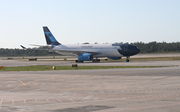
Mexicana introduced new livery in the second half of 2008. It consists of a eurowhite fuselage with the front in marine blue outlining a stylized eagle. The tail features the same eagle in marine blue with a light-blue background. New graphic design is the work of Gabriel Martínez Meave, a renowned Mexican designer who has received several international awards, most recent of them from the Type Directors Club.
Services
Cabin
Elite Class (former Ejecutiva)
Mexicana offers "Clase Elite", or business class, on all flights. Warm meals are served on all domestic and international flights on flights longer than 40 minutes. Passengers also receive snacks throughout the flight, selection of meals, and generous refreshments. The seats on the Boeing 767-300ER are 23 inches across and recline 160°; while seats on the Airbus 320 are 22 inches across and recline approx 100° degrees. The seats are dark blue with small Aztec logos embossed on the seat with a white headrest cover displaying Mexicana's logo in black. Catering services are provided by Executive Chef Enrique Olvera
- Airbus A318/A319/A320
- Wide and comfortable seats with adjustable headrests and electrical controls.
- Portable entertainment units with AVOD.
- Airline magazine Vuelo.
- Duty Free catalogue on select international flights.
- Complimentary newspapers on flights departing from hubs and focus cities.
- Environmental music at boarding and disembarking.
- 10 Music channels and complimentary headphones.
- Boeing 767-300
- Recliner seats with adjustable headrests, lowerback support, adjustable footrest, and electrical controls.
- Portable entertainment units with AVOD.
- Exclusive Hermès Clase Elite kit of amenities on flights to Europe and to South America
- Airline magazine Vuelo.
- Duty Free catalogue.
- Complimentary newspapers on flights departing from hubs and focus cities.
- Environmental music at boarding and disembarking.
- 10 Music channels and complimentary headphones.
- Airbus A330/Boeing 767-200
- Electric bed-seats with 3.5 feet of separation between rows.
- Entertainment units with AVOD.
- Exclusive Hermès Clase Elite kit of amenities on flights to Europe and to South America.
- Airline magazine Vuelo.
- Tourist Class with personal TV
- Duty Free catalogue.
- Complimentary newspapers on flights departing from hubs and focus cities.
- Environmental music at boarding and disembarking.
Economy Class
- Airbus A318/A319/A320
- Airline magazine Vuelo.
- Duty Free catalogue on select international flights.
- Complimentary newspapers on flights departing from hubs and focus cities.
- Environmental music at boarding and disembarking.
- 10 Music channels and complimentary headphones.
- Visual entertainment provided through overhead-compartment-screens.
- Boeing 767-200/300
- Personal kit of amenities.
- Airline magazine Vuelo.
- Duty Free catalogue on select international flights.
- Complimentary newspapers on flights departing from hubs and focus cities.
- Environmental music at boarding and disembarking.
- 10 Music channels and complimentary headphones.
- Visual entertainment provided through overhead-compartment-screens.
- Airbus A330
- Personal kit of amenities.
- Airline magazine Vuelo.
- Duty Free catalogue on select international flights.
- Complimentary newspapers on flights departing from hubs and focus cities.
- Environmental music at boarding and disembarking.
- 10 Music channels and complimentary headphones.
- AVOD (Audio & Video On-Demand) displayed through personal screens
Mexicana 'Elite' Lounge
Mexicana has the following lounges in the following airports: Mexicana Airlines Destinations
- Europe
* Spain
o Madrid - Barajas Airport
* United Kingdom
o London - London Gatwick Airport
Mexicana Airlines Destinations in North America
* Canada
o Calgary - Calgary International Airport
o Edmonton - Edmonton International Airport
o Montréal - Montréal-Pierre Elliott Trudeau International Airport
o Toronto - Toronto Pearson International Airport
o Vancouver - Vancouver International Airport
* Mexico
o Baja California
+ Mexicali - General Rodolfo Sánchez Taboada International Airport
+ Tijuana - General Abelardo L. Rodríguez International Airport
o Baja California Sur
+ Los Cabos - Los Cabos International Airport
o Chiapas
+ Tuxtla Gutiérrez - Angel Albino Corzo International Airport
o Distrito Federal
+ Mexico City - Mexico City International Airport Hub
o Guanajuato
+ León - Del Bajío International Airport
o Guerrero
+ Acapulco - General Juan N. Álvarez International Airport
o Jalisco
+ Guadalajara - Don Miguel Hidalgo y Costilla International Airport Hub
+ Puerto Vallarta - Lic. Gustavo Díaz Ordaz International Airport
o Michoacán
+ Morelia - General Francisco J. Mujica International Airport
o Nuevo León
+ Monterrey - General Mariano Escobedo International Airport
o Oaxaca
+ Oaxaca - Xoxocotlan International Airport
o Quintana Roo
+ Cancún - Cancún International Airport Focus City
o Zacatecas
+ Zacatecas - General Leobardo C. Ruiz International Airport
Top
* United States of America
o Chicago - O'Hare International Airport
o Dallas/Fort Worth - Dallas-Fort Worth International Airport
o Denver - Denver International Airport
o Fresno - Fresno Yosemite International Airport
o Las Vegas - McCarran International Airport
o Los Angeles - Los Angeles International Airport
o Miami - Miami International Airport
o New York City - John F. Kennedy International Airport
o Oakland - Oakland International Airport
o Orlando - Orlando International Airport
o Sacramento - Sacramento International Airport
o San Antonio - San Antonio International Airport
o San Francisco - San Francisco International Airport
o San Jose - San Jose International Airport
Mexicana Airlines Destinations in Caribbean
* Cuba
o Havana - José Martí International Airport
Mexicana Airlines Destinations in Central America
* Costa Rica
o San José de Costa Rica - Juan Santamaría International Airport
* El Salvador
o San Salvador - Cuscatlan International Airport
* Guatemala
o Guatemala City - La Aurora International Airport
* Panama
o Panama City - Tocumen International Airport
Top Mexicana Airlines Destinations in South America
* Argentina
o Buenos Aires - Ministro Pistarini International Airport
* Brazil
o São Paulo - Guarulhos International Airport
* Colombia
o Bogotá - El Dorado International Airport
* Venezuela
o Caracas - Simón Bolívar International Airport
Mexicana Airlines Destinations in Terminated destinations North America
* Mexico - Aguascalientes, Ciudad Juárez, Culiacán, Hermosillo, Ixtepec, Mazatlán, Minatitlán, Tapachula, Tuxpan, Veracruz/Coatzacoalcos * United States - Bakersfield, Baltimore/Washington, Kansas City, Newark, Philadelphia, Portland, St. Louis
Caribbean
* Dominican Republic - Santo Domingo * Puerto Rico - San Juan
Central America
* Nicaragua - Managua
South America
* Chile - Santiago * Ecuador - Guayaquil, Quito * Peru - Lima
Top Mexicana Airlines Terminated destinations
North America
* Mexico - Aguascalientes, Ciudad Juárez, Culiacán, Hermosillo, Ixtepec, Mazatlán, Minatitlán, Tapachula, Tuxpan, Veracruz/Coatzacoalcos * United States - Bakersfield, Baltimore/Washington, Kansas City, Newark, Philadelphia, Portland, St. Louis
Caribbean
* Dominican Republic - Santo Domingo * Puerto Rico - San Juan
Central America
* Nicaragua - Managua
South America
* Chile - Santiago * Ecuador - Guayaquil, Quito * Peru - Lima
See also
- Oneworld alliance
- Puertorriqueña de Aviación (established 1941), inspired by Mexicana de Aviación and Cubana de Aviación.
References
- ↑ "Directory: World Airlines". Flight International: p. 50. 2007-04-10.
- ↑ 2.0 2.1 "Mexicana’s uncertain future: Big network shake-up posed by possible removal of biggest player; 30% of domestic market and 20% of US-Mexico market up for grabs". anna.aero. http://www.anna.aero/2010/08/11/mexicanas-uncertain-future-big-network-shake-up-posed-by-removal-of-biggest-player/.
- ↑ Nasdaq.com
- ↑ "Mexicana sinks into restructuring". http://www.flightglobal.com/articles/2010/08/17/346251/mexicana-sinks-into-restructuring.html. Retrieved 2010-08-17.
- ↑ Mozee, Carla (2010-08-27). "Airline Mexicana to suspend operations indefinitely". MarketWatch. http://www.webcitation.org/5sJJBihGq. Retrieved 2010-08-27.
- ↑ 6.0 6.1 6.2 6.3 Flight International 12–18 April 2005
- ↑ "Mexico to sell Mexicana Airline," Houston Chronicle, May 24, 1989.
- ↑ Oneworld (21 September 2009). "Mexicana to become part of oneworld on 10 November". Press release. http://www.oneworld.com/ow/news/details?objectID=19405. Retrieved 22 September 2009.
- ↑ Grupo Mexicana was granted a concession for a new airline
- ↑ Mexicana ultimately decided to extend the existing flight from JFK to Monterrey, Mexico to Guadalajara.Compania Mexicana de Aviacion, S.A. de C.V. - Exemption - Guadalajara-New York
- ↑ http://www.bloomberg.com/news/2010-08-03/mexicana-files-for-bankruptcy-protection-says-flights-won-t-be-affected.html
- ↑ http://cmainforma.com/cma-informs/
- ↑ http://www.bloomberg.com/news/2010-08-10/mexicana-offers-unions-a-stake-in-holding-company-as-part-of-new-contract.html
- ↑ "Mexican consortium attempting Mexicana rescue". 2010-08-24. http://atwonline.com/airline-finance-data/news/mexican-consortium-attempting-mexicana-rescue-0823. Retrieved 2010-08-24.
- ↑ Julia Galiano-Rios (2010). "Mexicana airlines ceases flights after bankruptcy". Associated Press. http://www.msnbc.msn.com/id/38895875/ns/world_news-americas/. Retrieved 2010-08-28.
- ↑ "Aeromexico Informs." Aeroméxico. Retrieved on August 29, 2010.
- ↑ "American Airlines and American Eagle help customers affected by Mexicana airlines service suspension." American Airlines. August 30, 2010. Retrieved on August 30, 2010.
- ↑ "Puerto Vallarta Bridge And Mexicana Travel Policies." American Airlines. September 1, 2010.
- ↑ Information - Alliances
- ↑ [1]
External links
- Official website (English)/(Spanish)
- Grupo Mexicana Informs (English)
|
||||||||||||||||||||||||||||||||||||||||||||||||||||||||||||||||||||||||||||||||||||||||||||||||||||||
|
|||||
|
|||||